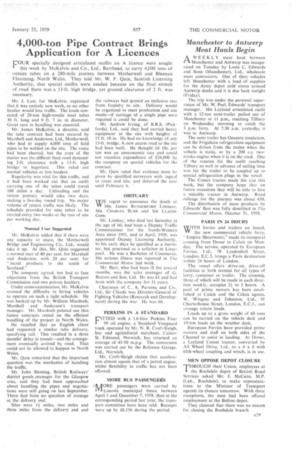4,000-ton Pipe Contract Brings Application for A Licences
Page 33

If you've noticed an error in this article please click here to report it so we can fix it.
pOUR specially designed articulated outfits on A licence were sought
this week by McKelvie and Co., Ltd., Barrhead, to carry 4,000 tons of outsize tubes on a 280-mile journey between Motherwell and Blaenau Ffestiniog, North Wales. They told Mr. W. F. Quin, Scottish Licensing Authority, that special outfits were needed because on the final stretch of road there was a 13-ft. high bridge, yet ground clearance of 2 ft. was necessary.
Mr. J. Law, for McKelvie, explained that it was entirely new work, so no other haulier would lose traffic. The loads consisted of 20-ton high-tensile steel tubes 30 ft. long and 9 ft. 7 in. in diameter, Great care in handling was essential.
Mr. James McKelvie, a director, said the tube contract had been secured by Marshall and Anderson, Ltd., Motherwell, who had to supply 4,000 tons of field pipes to be welded on the site. The route had been charted, but the crux of the matter was the difficult final road demanding 2-ft. clearance with a I3-ft. high bridge to negotiate. This ruled out normal vehicles or low-loaders.
Regularity was vital for this traffic, and it had been worked out that an outfit carrying one of the tubes could travel 100 miles a day. Unloading and the return journey would take two days, making a five-day round trip. No major volume of return traffic was likely. The schedule provided for nine tubes to be carried every two weeks at the rate of one per working day.
Normal User Suggested Mr. McKelvie added that if there were any capacity to spare, the Motherwell Bridge and Engineering Co., Ltd., would take it up. At this, Mr. Quin suggested a normal user of 80 per cent. for Marshall and Anderson, with 20 per cent. for "metal products to the south of Scotland."
The company agreed, but had to face objections from the British Transport Commission and two private hauliers.
Under cross-examination, Mr. McKelvie stressed the difficulty in hiring vehicles to operate on such a tight schedule. He was backed up by Mr. William Murdoch, Marshall and Anderson's transport manager. Mr. Murdoch pointed out that future contracts rested on the efficient handling of the project in North Wales.
He recalled that an English client had requested a similar tube delivery, specifying rail. This resulted in a three months' delay in transit—and the consignment eventually arrived by road. That could not be allowed to happen in North Wales.
Mr. Quin remarked that the important question was the mechanics of handling the traffic.
Mr. John Sleming, British Railways' district goods .manager for the Glasgow area, said they had been approached. about handling the pipes and negotiations were still going on last September. There had been no question of cranage at the delivery end.
Sites were if miles, two miles and three miles from the delivery end and the railways had quoted an inclusive rate from foundry to site. Delivery would be organized to meet production and site needs—if carriage of a single pipe were required it could be done.
Mr. Andrew Irving, of B.R.S. (Pickfords), Ltd., said they had carried heavy equipment to the site with heights of 15 ft. 10 in. He had no knowledge of any 13-ft. bridge. A new access road to the site had been built. He thought £4 10s. per ton was an uneconomic rate and could not visualize expenditure of £24,000 by the company on special vehicles for the contract.
Mr. Quin ruled that evidence must be given by qualified surveyors with regard to route and site, and deferred the case until February 6. '
OBITUARY
WE regret to announce the death of VI' M.R. JAMES RUTHERFORD LINDSAY. MR. CHARLES BURR and SIR CLAUDE GIBE.
Mr. Lindsay, who died last Saturday at the age of 60, had been a Deputy Traffic Commissioner for the North-Western Area since 1951, and in April, 1956, was appointed Deputy Licensing Authority. In his early days he qualified as a barrister, but practised as a solicitor in Liverpool. He was a Bachelor of Commerce. His serious illness was reported in The Commercial Motor last week.
Mr. Burr, who had been ill for several months, was the sales manager of G. Beaton and Son, Ltd. He was 61 and had been with the company for 31 years.
Chairman of C. A. Parsons and Co., Ltd., Sir Claude was Director-General of Fighting Vehicles (Research and Development) during the war. He was 60.
PERKINS IN A STANDARD
FILD with a 1.6-litre Perkins Four I 99 oil engine, a Standard Vanguard truck operated by Mr. N. R. Croft-Sleigh, hay and agricultural merchant, Caistor St. Edmund, Norwich, has returned an average of 45-50 m.p.g. The conversion was carried out by the Reliance Garage, Ltd., Norwich.
Mr. Croft-Sleigh claims that acceleration almost equals that of a petrol engine, whilst flexibility in traffic has not been affected.
MORE BUS PASSENGERS
,&lkiTORE passengers were carried by Lincoln municipal buses between April 1 and December 7, 1958, than in the corresponding period last year, the transport committee have been told. Receipts were up by £6,156 during the period.




































































































































































































